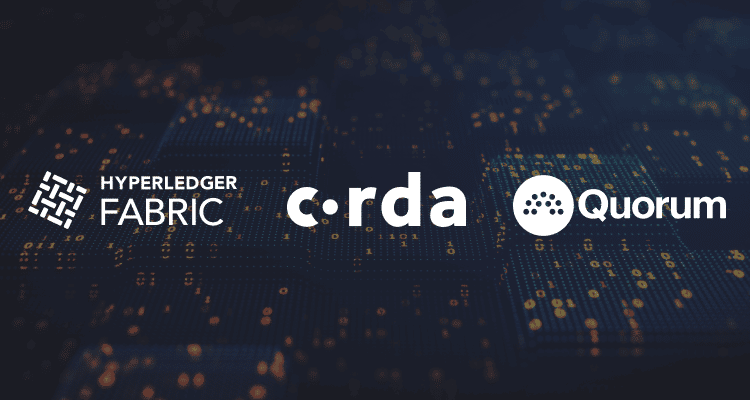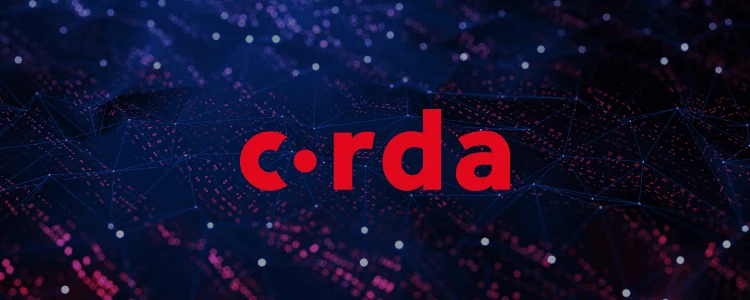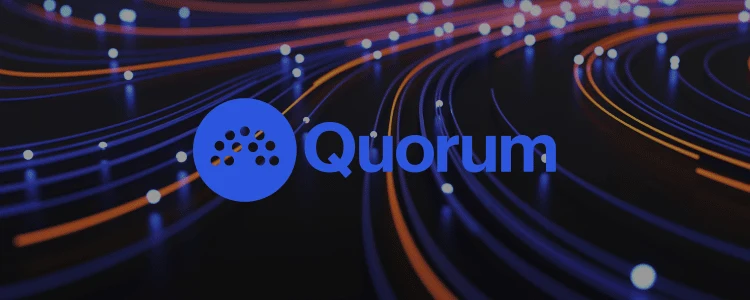Hyperledger vs Corda vs Quorom: What’s The Best Blockchain for Business?

Blockchain technology, although new, has been warmly received by the current generation. With a projected $23 million increase in global revenue by 2023, blockchain has demonstrated its potential to be one of the most robust technological innovations in the last few years. Distributed ledger technologies have evolved, with two permissionless public blockchains, Bitcoin and Ethereum, paving the road in early days. The latest technology development has been with software like Hyperledger Fabric, Corda, and Quorum, which are permissioned enterprise blockchains.
Enterprise blockchains like Hyperledger Fabric, Corda, and Quorum have their strengths. For instance, Hyperledger Fabric adapts to your needs, whether you work with healthcare products, real estate, or the financial industry. Corda was created to automate the recording of legal agreements between identified parties, while Quorum was designed for the financial services industry to guarantee transaction and contract privacy.
As a result, many blockchain users (businesses or individuals) differentiate between these enterprise blockchains and which one is best to adopt into their companies. Read on.

What is Corda?
The R3 Corda Distributed Ledger Technology platform uses a point-to-point data broadcast system. Corda enterprise is an open-source enterprise-based blockchain developed to provide interoperability. It is a system for managing, synchronizing, recording agreements and transferring assets.
It allows businesses to quickly and effectively incorporate Blockchain across their processes while retaining transparency and resolving privacy-related concerns. Also, Corda provides timestamping services to sequentially order transactions and disregard conflicts. It contains a smart contract logic that establishes restrictions to guarantee that state transitions are legal as per the contract code.
Corda business network eliminates a single principal ledger in favor of only allowing the network’s entities directly involved in the transaction to access transactional data. This raises the bar for node privacy by carefully limiting data exchange to nodes that need it. The combination of states and transactions allows Corda to accomplish this. In Corda, transaction execution is private by default, consisting of private data collection.
Transactions use the inputs from the current states to perform the required action and offer a prospective new state. Once confirmed, the prospective new states take the place of the current ones, classifying the former as historic. The Corda network connects all contracts on a chain to a legally binding document that specifies their intended purpose by allowing an object to be embedded in the code.
This makes it easier to avoid the current ambiguity around the legal enforceability of smart contracts. However, each node in a permissioned network must be authorized and connected to a registered body, creating additional legal accountability.
Corda Architecture
Corda architecture consists of the following components:
- States
- Contracts
- Transactions
- Corda Flows
- Consensus
- Corda Node
Benefits of Corda
Some of the key benefits of using Corda include the following:
- Corda has a high degree of flexibility and agility in meeting business objectives. This shows that firms can adapt and maintain better growth with it.
- Corda Supports Open Development: Corda is an open-source project with a large developer community trying to improve its features, functionality, and upgrades.
- Corda has performance-based evidence. You can manage the increasing network activity with its 600 transactions per second processing capacity.
- Corda has excellent scalability and can store and handle data through a ledger.
- Secure and Private: Unlike other ledgers, Corda employs a unique method. You will only be able to disclose the transaction history in situations when it is necessary. To guarantee the security of their data, you can also host the nodes inside the company firewall. Also, Corda uses HSM integration to ensure the security of the critical signing procedure.
- Corda can be set up using Docker for greater flexibility and scalability and hosted on cloud solutions.
- Corda can carry out transactions and is fully compatible and interoperable with other blockchain networks. As a result, it is one of the best platforms for fostering blockchain interoperability.

What is Hyperledger Fabric?
Hyperledger Fabric, an open-source blockchain infrastructure managed by the Linux Foundation, supports a multichannel global broadcast infrastructure. Hyperledger Fabric is a modular blockchain framework that can be used to build blockchain-based goods, services, and applications intended for usage by private businesses with the help of plug-and-play components.
Blockchain technology is built as part of an open-source project with a modular architecture, allowing businesses to customize it to their specific needs. Because it is open-source, anyone may freely expand on it. A Hyperledger Fabric network will enable you to create multiple channels or private collections for each private collaboration. Although this allows for greater flexibility, it can also lead to complicating network management.
The fabric allows updating private and public data in the same transaction; hence, asset ownership changes are visible to everyone, but prices are only visible between seller and buyer. There are different ledgers for each channel in a network. The Hyperledger Fabric consists of two parts: the world state and the transaction log.
The term “world state” refers to a database that always contains the most recent state of the channel-specific ledger. At the same time, the transaction log is a permanent record of every transaction that resulted in the current state of the world. It can serve as the ledger’s verifiable source trail. Each peer on a network would keep a ledger record for every channel they are involved in.
The Hyperledger Fabric platform works with a relatively modular architecture outside its core infrastructure. As a result, the network’s components—such as identity management, consensus, or encryption—can be chosen from a wide range of possibilities, making it both comprehensive and adaptable. Hyperledger Fabric can be used for various use cases owing to this customization, which enables network managers to pick the characteristics most suitable to their unique situation.
Hyperledger Architecture
The Hyperledger architecture consists of the following components:
- Consensus Layer
- Smart Contract Layer
- Communication Layer
- Data Store Abstraction
- Crypto Abstraction
- Identity Services
- Policy Services
- APIs
- Interoperation
Benefits of Hyperledger
Hyperledger is a canopy that brings manufacturers, users, and developers from many industries and market niches. Hyperledger creates a greenhouse structure that fosters the development of novel ideas and provides the required materials. The Hyperledger greenhouse structure has many advantages, including:
- Monitoring developments
- Improved productivity
- Cooperation to reduce duplication of effort
- Improved code quality control
- Protection of intellectual property

What is Quorum?
Quorum is an open-source enterprise-focused Ethereum blockchain protocol explicitly created for use in private blockchain networks. A single member owns all the nodes or consortium blockchain networks in which multiple members hold a part of the network. Because it is built on Ethereum, it uses smart contracts to speed up transactions within the blockchain. The Quorum layer aims to establish the permissioned structure and privacy protections required for enterprise use, primarily in the financial industry.
Quorum is a form of blockchain that is fast, has a high throughput, and aids in protecting user privacy. It helps securely conceal transaction details while providing high-speed processing and performance. To achieve this, an innovative contract architecture that allows the division of private data is added to the shared, single blockchain.
With this technique, each node on a network keeps both a public and a private state database. Nodes will only carry out ledger-update smart contracts if they are parties. Therefore, a node is not a party to a particular private contract and will not keep that information. Notwithstanding, each node on the network can guarantee that every network transaction exists in a cryptographically secured form.
Architecture of Quorum
Quorum architecture consists of three components, namely:
- Quorum Node (modified Geth Client)
- Constellation- Transaction Manager
- Constellation: Enclave
Benefits of Quorum
Using Quorum has many significant advantages, including:
- Privacy: Constellation is a peer-to-peer encrypted message exchange used by the platform to transmit private data to network users. However, it allows both private transactions and private contracts.
- Alternative Consensus Mechanisms: Quorum provides additional consensus mechanisms that are more suitable for consortium chains in place of the standard Proof-of-Work and Proof-of-Stake algorithms. A consortium blockchain is semi-private and has a defined user base.
- Peer Permissioning: It enables node/peer permissions, which helps in ensuring that only well-known parties join the network through the use of smart contracts.
- Higher Performance: Quorum offers much better performance than public geth (Ethereum) because it is more resilient and able to execute more transactions per second than Bitcoin and Ethereum combined.
Differences between Hyperledger, Quorum, and Corda
Although hyperledger, Quorum, and Corda are private networks and permissioned blockchains, the three distributed ledger technologies differ in their use case and vision. However, we will consider the following:
- Node permissions
All three private, permissioned blockchains—Hyperledger, Quorum, and Corda—have strict restrictions on who can join the distributed blockchain network. The admittance of participants into the blockchain and the rights of the other nodes/peers are controlled by a governing authority, which is often a group of members.
Therefore, in Hyperledger, the governing peers approve and grant other nodes authorization for all transactions. This access restriction can be applied at the node, channel, or consortium levels. The setups for accessing nodes and their permissions in Corda are based on files. Unlike other blockchains, Corda only distributes data to those who need it instead of broadcasting it globally.
On the other hand, Quorum uses smart contracts to define node permissioning. Technically, it is maintained with a JSON file with a permission flag.
- Consensus Algorithm
A consensus algorithm is a computer science technique that facilitates agreement between computers or distributed processes on a particular data value. It helps a network that contains multiple faulty nodes achieve reliability. Consensus algorithms are used to solve consensus problems.
With Hyperledger, many transactions can be carried out simultaneously, enhancing system performance instead of being carried out sequentially. Hyperledger uses the KAFKA and RAFT algorithms to reach a consensus to implement and verify transactions. Corda was created to assist banks and other financial organizations in addressing issues unique to this industry.
As a result, Corda created the idea of “Notaries,” who approve transactions and add new blocks to the chain. In Corda, many features are only available in the Enterprise version, like commercial databases (Oracle, MSSql), HSM, parallel flow execution, high availability mode, and private network deployment tools. Quorum, on the other hand, uses the QuorumChain protocol to achieve consensus. This blockchain uses the BFT and RAFT algorithms and a straightforward voting system that uses majority rule to confirm transactions.
- Smart Contract Logic
The business logic of Hyperledger is based on the Chaincode. Any common programming language, including Java, Go, and Node.js, can be used to create Chaincode. Since Corda was designed for banks and financial institutions and strongly emphasizes the necessity of parties entering into a legally binding agreement, Corda uses smart contracts in combination with Ricardian contracts to achieve validity and security. The smart contract for Corda can be created using Java or Kotlin programming languages. Quorum uses Solidity programming language for both public and private contracts.
- Currency/Tokens
Hyperledger allows users to create digital tokens and native currencies using the FabToken token management system. Corda provides an SDK that supports the creation, distribution, and trading of native tokens. The Quorum Blockchain uses the JPM coin as its digital currency.
Conclusion
Blockchain technology has ushered in a new era of the internet that is ideal for sharing information with financial value. Blockchain has the potential to transform different sectors of the world entirely. Each type of blockchain has distinct benefits and is advancing the efficient operation of businesses in other industries.
Enterprise blockchains are highly sought-after and in high demand due to their scalability and adaptability. All three platforms—Hyperledger, Corda, and Quorum—offer scalability, security, and privacy while enhancing the performance of blockchains. Therefore, businesses can choose which blockchain is more relevant and adaptable to their business demands. Contact ServerMania for your professional-grade hybrid and scalable cloud servers for your enterprise blockchains.
Was this page helpful?

